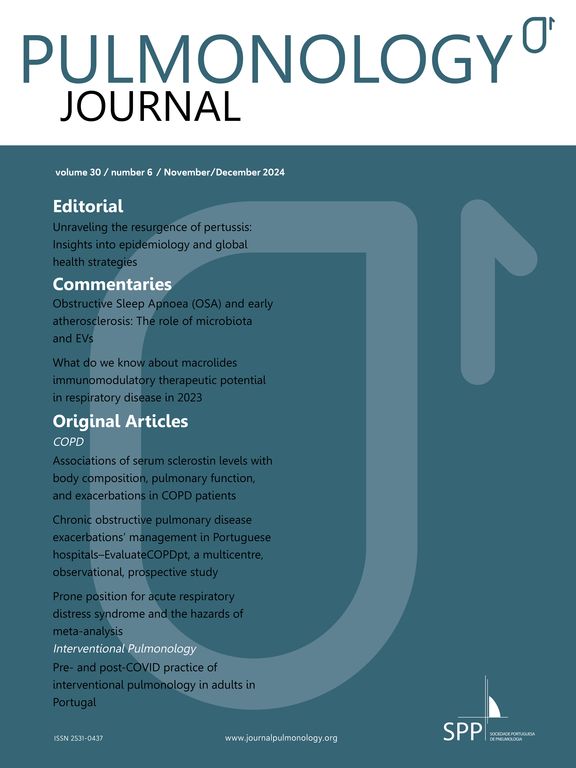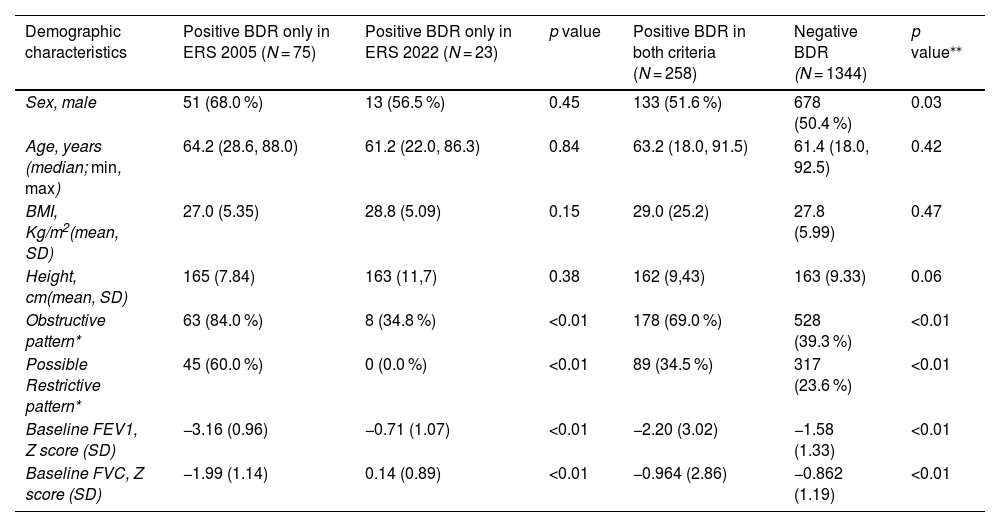Bronchodilator response (BDR) is a measurement of the degree of volume and airflow improvement in response to an inhaled short-acting bronchodilator. It is widely used in clinical practice to diagnose respiratory diseases such as chronic obstructive pulmonary disease (COPD) or asthma, to assess asthma control, and predict the response to inhaled treatment.1
In the 2022 ERS/ATS interpretive strategies for routine lung function tests, a positive BDR was updated as a change of >10 % relative to the predicted value in forced expiratory volume in 1 second (FEV1) or forced vital capacity (FVC)2, in contrast to the 2005 ERS/ATS recommendations, which required a change in FEV1 or FVC ≥12 % and ≥200 mL of the initial value.3
According to the literature, an individual's height, age and even sex are related to the absolute and relative changes that occur in FEV1 and FVC.4 By expressing BDR as the percent change relative to the individual's predicted value it is thought to minimize potential sex and size bias.4 The new criteria consider each patient's individual characteristics.2
Some studies showed that compared with the 2005 recommendations, the proportion of positive BDR is noticeably reduced in patients with asthma and COPD in the 2022 recommendations, although their trends with the degree of airflow obstruction do not seem to change.5 In one paper by Betancor et al., positive BDR with both criteria was associated with low spirometry values (FEV1, FVC and FEV1/FVC).6
Limited data exists on comparing the two criteria and their impact in clinical practice.
We performed a comparative study on the BDR test according to 2005 vs. 2022 ATS/ERS definition. A retrospective analysis on the BDR test was conducted from October 2018 to March 2020.
Categorical variables were described with absolute and relative frequencies and compared using Chi-square or Fisher's exact test. Continuous variables were described by means and standard deviations (unless otherwise specified). Comparisons of continuous variables were performed using Independent T test or Mann-Whitney (2 groups), and ANOVA or Kruskall-Wallis (4 groups). Statistical significance was defined at 5 %, and the statistical analysis was all performed in R Statistical Software (v4.1.2).
A total of 1700 bronchodilation tests were analysed. The baseline characteristics of the population are described in Table 1. Patients were predominately male (n = 875; 51.5 %), and the median age was 61.7 years-old (18.0, 92.5). The mean BMI was 28.0 (±11.2) kg/m2, and the mean height was 163.0 (±9.3) cm. Concerning the spirometry pattern, 777 (45.7 %) presented with an FEV1/FVC inferior to the lower limit of normal (LLN), and 451 (26.5 %) with a FVC
Baseline characteristics of the population.
| Demographic characteristics | Overall (N = 1700) |
|---|---|
| Sex, male | 875 (51.5 %) |
| Age, years (median; min, max) | 61.7 (18.0, 92.5) |
| BMI, Kg/m2 | 28.0 (11.2) |
| Height, cm | 163 (9.33) |
| Obstructive pattern* | 777 (45,7 %) |
| Possible Restrictive pattern* | 451 (26,5 %) |
BMI: Body Mass Index, cm: centimetres, Kg: kilograms, m: meters, SD: standard deviation.
A total of 333 (19.6 %) tests were positive according to 2005 ATS/ERS, compared to 281 (16.5 %) according to 2022 ATS/ERS definition. 1344 (79.1 %) tests were negative in both criteria. The coincidence rate (negative/negative or positive/positive) occurred in 94.2 % of the sample. BDR positivity was documented on 75 (4.4 %) tests only according to 2005 ATS/ERS, on 23 (1.4 %) tests only according to 2022 ATS/ERS and 258 (15.2 %) in both criteria (Table 2), which means that 5.8 % of the tests the result changed from 2005 to 2022 criteria, from positive to negative result (4.4 %; n = 75) and from negative to positive (1.4 %; n = 23) - a statistically significant change (p < 0.001).
Comparative characteristics according to BDR results.
| Demographic characteristics | Positive BDR only in ERS 2005 (N = 75) | Positive BDR only in ERS 2022 (N = 23) | p value | Positive BDR in both criteria (N = 258) | Negative BDR (N = 1344) | p value⁎⁎ |
|---|---|---|---|---|---|---|
| Sex, male | 51 (68.0 %) | 13 (56.5 %) | 0.45 | 133 (51.6 %) | 678 (50.4 %) | 0.03 |
| Age, years (median; min, max) | 64.2 (28.6, 88.0) | 61.2 (22.0, 86.3) | 0.84 | 63.2 (18.0, 91.5) | 61.4 (18.0, 92.5) | 0.42 |
| BMI, Kg/m2(mean, SD) | 27.0 (5.35) | 28.8 (5.09) | 0.15 | 29.0 (25.2) | 27.8 (5.99) | 0.47 |
| Height, cm(mean, SD) | 165 (7.84) | 163 (11,7) | 0.38 | 162 (9,43) | 163 (9.33) | 0.06 |
| Obstructive pattern* | 63 (84.0 %) | 8 (34.8 %) | <0.01 | 178 (69.0 %) | 528 (39.3 %) | <0.01 |
| Possible Restrictive pattern* | 45 (60.0 %) | 0 (0.0 %) | <0.01 | 89 (34.5 %) | 317 (23.6 %) | <0.01 |
| Baseline FEV1, Z score (SD) | −3.16 (0.96) | −0.71 (1.07) | <0.01 | −2.20 (3.02) | −1.58 (1.33) | <0.01 |
| Baseline FVC, Z score (SD) | −1.99 (1.14) | 0.14 (0.89) | <0.01 | −0.964 (2.86) | −0.862 (1.19) | <0.01 |
BMI: Body Mass Index, cm: centimetres, FEV1: forced expiratory volume in 1 second, FVC: forced vital capacity, Kg: kilograms, m: meters, SD: standard deviation.
In the positive to negative group (4.4 %; n = 75), the most common previously established diagnosis were COPD (32.0 %), Asthma-COPD overlap syndrome (25.3 %) and asthma (18,6 %). There were no statistically significant differences in age, BMI and height compared with the other groups, but this subset of patients seemed to have lower baseline FEV1 Z score (−3.16 (0.956) vs −0.713 (1.07) in the only positive in the 2022 criteria, p < 0.01) and FVC (−1.99 (1.14) vs 0.142 (0.885), p < 0.01), corresponding to a more severe degree of flow obstruction. This finding was consistent with recent literature, which stated patients with consistent positive BDR had a higher initial percentage of predicted FEV1 and FVC.5
A smaller percentage of patients changed from the negative to positive group (1,3 %, n = 23), and the most common diagnosis were miscellaneous (34,8 %), COPD (30,4 %) and asthma (17,4 %). No significant differences in age, BMI, or height were found when comparing with other groups.
Concerning the parameter where positivity was found, in the 2022 ATS/ERS criteria, positivity occurred only on FEV1 in 31.7 %, only on FVC in 41.3 %, and both FEV1 and FVC in 27.0 %.
In this sample there was a significant decrease in the percentage of positive BDR according to the new recommendation (19.6 % to 16.5 %). Based on the results, the new criteria seem to be more effective in detecting positive BDR in less obstructive patients, potentially missing it in clearly obstructed patients, who are typically less suitable for other tests, such as methacholine challenge. The authors suggest both criteria could be used based on patient profile and suspicion, but further expert discussion is needed.
This research did not receive any specific grant from funding agencies in the public, commercial, or not-for-profit sectors.








